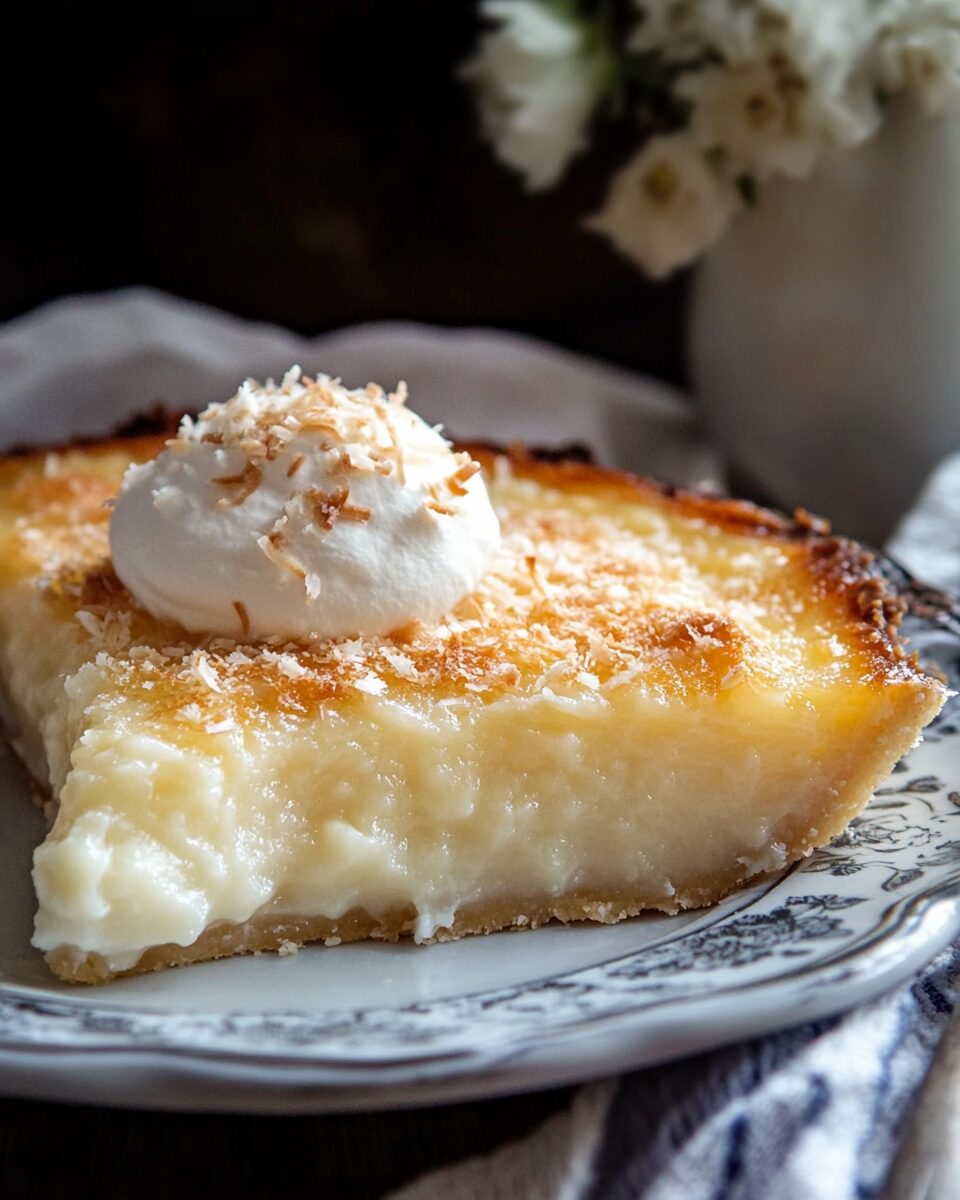The Coconut Pie is an old-fashioned dessert that’s both simple to make and deeply satisfying. With a golden top and a creamy custard filling enriched with sweetened shredded coconut, it practically makes its own crust in the oven, delivering a texture that’s somewhere between a custard and a cake.
Ideal for holidays, gatherings, or just a cozy night in, this pie takes you back to grandma’s kitchen with every bite. The hint of vanilla, the richness of eggs and butter, and the sweet crunch of toasted coconut make this dessert a true Southern-inspired treat. Serve it chilled or room temp—it’s a winner either way.
Full recipe:
Ingredients:
-
1 cup sweetened shredded coconut
-
1/2 cup all-purpose flour
-
1 1/2 cups white sugar
-
1/4 cup unsalted butter, melted
-
2 eggs
-
1 teaspoon vanilla extract
-
2 cups milk
-
Pinch of salt
Directions:
-
Preheat your oven to 350°F (175°C).
-
In a large mixing bowl, combine the flour, sugar, and a pinch of salt.
-
Add the melted butter, eggs, vanilla extract, and milk. Mix until well blended.
-
Stir in the shredded coconut.
-
Pour the mixture into a greased 9-inch pie plate.
-
Bake for 45–50 minutes or until the top is golden brown and the center is set.
-
Allow to cool at room temperature. The pie will form its own crust during baking.
-
Chill before serving for best texture and flavor.
Prep Time: 10 minutes | Cooking Time: 50 minutes | Total Time: 1 hour
Kcal: 325 kcal | Servings: 8 servings
The History Behind Coconut Pie
Coconut Pie traces its roots back to early American baking traditions, particularly in the Southern United States. In times when refrigeration was limited and ingredients were basic, cooks relied on pantry staples like sugar, flour, eggs, and butter. The addition of coconut—often canned or dried and preserved—added exotic flair to otherwise simple desserts.
Coconut itself became widely available in the U.S. during the late 19th and early 20th centuries, and it quickly became a favorite for bakers. Pies like this one emerged as creative uses of limited ingredients, where texture and flavor could be maximized with minimal effort.
What’s fascinating about this Coconut Pie is that it bakes into layers—the flour and eggs settle slightly to create a soft crust-like bottom, the middle becomes custard-like, and the coconut rises to toast on top. This natural separation makes it feel like a multi-layered dessert in one easy bake.
Why This Pie Is So Loved
One of the reasons Coconut Pie holds a cherished place in so many homes is its balance of sweet and comforting flavors. The toasted coconut gives a slightly chewy texture and caramelized bite, while the custard provides a velvety, melt-in-your-mouth experience.
For busy households or beginner bakers, the one-bowl method is a dream. No rolling, no chilling, no par-baking—just mix and pour. Plus, its presentation is gorgeous straight from the oven, with the golden coconut top naturally crisping into a picture-perfect finish.
Many fans of this recipe find that it bridges the gap between pie and cake. It’s hearty enough to serve warm with a scoop of ice cream, yet refined enough to serve at brunch, tea time, or holidays.
Coconut Pie vs. Coconut Cream Pie
It’s easy to confuse Coconut Pie with its cousin, the Coconut Cream Pie, but they are quite different in preparation and experience. Coconut Cream Pie is typically made with a cooked custard base poured into a pre-baked pie crust and topped with whipped cream. It’s chilled and served cold.
Coconut Pie, on the other hand, is a bake-it-all-together kind of dish. Everything goes into one bowl, and it sets as it bakes, creating distinct textures without the need for additional toppings or crust. It’s rustic, warm, and deeply satisfying—closer in spirit to a Southern buttermilk pie than a diner-style cream pie.
Tips for the Best Coconut Pie
Even though this pie is simple, a few techniques can make it truly shine. Using high-quality, full-fat milk adds richness to the custard. Some bakers prefer to scald the milk (heating it just below boiling) before incorporating it for a smoother texture, though it’s not essential.
Sweetened shredded coconut is the go-to, as it contributes both flavor and moisture, but for those watching sugar intake, unsweetened coconut can be substituted. Just be mindful that it will alter the sweetness of the final pie.
Don’t be tempted to skip the resting time—letting the pie cool completely before slicing ensures that it holds together beautifully and allows the flavors to settle. For an extra twist, consider adding a pinch of nutmeg or lemon zest to the batter.
Variations and Creative Twists
Coconut Pie is incredibly versatile, and once you’ve mastered the base, there are countless directions you can go:
-
Coconut Rum Pie: Add a tablespoon of dark or coconut rum for depth and aroma.
-
Coconut Lime Pie: Add lime zest and a splash of lime juice for a tropical citrus note.
-
Toasted Coconut Topping: For added texture, toast some additional coconut separately and sprinkle it on top after baking.
-
Chocolate Coconut Pie: Stir in mini chocolate chips or swirl in melted dark chocolate before baking.
-
Nutty Coconut Pie: Add crushed pecans or almonds to the mixture for added crunch and a nutty undertone.
These small changes can elevate the pie from a familiar classic to a personal signature dessert that reflects your culinary style.
Serving Suggestions
Coconut Pie is delightful served at room temperature, but it can also be served cold straight from the fridge. It pairs beautifully with a dollop of whipped cream or a scoop of vanilla ice cream. For a fancier presentation, a drizzle of caramel or chocolate sauce can add an indulgent touch.
If you’re hosting brunch or a dessert table, cut the pie into smaller squares instead of slices. The texture holds well enough to be served finger-food style on dessert platters or buffet tables.
Coffee and tea are natural companions for this pie, especially those with notes of vanilla, caramel, or spice. A warm cup of chai or an iced vanilla latte makes for a cozy pairing.
Storage and Shelf Life
Properly stored, Coconut Pie can last for several days in the refrigerator. Cover it tightly with plastic wrap or place it in an airtight container. Since the pie contains dairy and eggs, refrigeration is important to maintain safety and texture.
You can also freeze Coconut Pie. Once cooled completely, wrap it tightly in foil and place in a freezer-safe bag. It can be frozen for up to 2 months. Thaw in the refrigerator overnight before serving, and warm it briefly in the oven if you prefer it served warm.
Health Considerations
While Coconut Pie is undoubtedly indulgent, you can lighten it up if needed. Use a sugar substitute for a lower-carb version, or swap out whole milk with a lactose-free or plant-based milk like almond or oat (though this will slightly change the consistency).
Egg substitutes can also be used for a vegetarian version, although the texture may be less custardy. Always test small batches first if you plan to modify for dietary reasons.
The coconut itself, especially if unsweetened, offers fiber and healthy fats. However, this pie remains a treat to be enjoyed in moderation—ideal for celebrations, holidays, and those “just because” baking moments.
The Emotional Value of Homemade Coconut Pie
Coconut Pie isn’t just a dessert—it’s a slice of tradition, a memory on a plate. It’s the kind of recipe passed down in handwritten cards, scribbled in the margins of old cookbooks, or shared during family reunions. Every bite can bring back memories of grandmothers in the kitchen, Sunday dinners, and warm kitchen aromas.
That’s why this pie continues to endure. It’s affordable, adaptable, and reliably delicious. Whether it’s your first time making it or your fiftieth, it has that rare ability to feel both fresh and familiar at once.
Conclusion: Why Coconut Pie Deserves a Spot in Your Baking Repertoire
Coconut Pie is the unsung hero of homemade desserts. With minimal ingredients, no-fuss prep, and extraordinary payoff, it’s a must-bake for anyone who loves classic comfort food. Its unique texture, self-forming crust, and rich flavor make it a showstopper that doesn’t require flashy techniques or expensive ingredients.
Perfect for holidays, casual gatherings, or an everyday indulgence, this pie brings joy to the table and warmth to the heart. Whether you stick to the traditional version or experiment with your own twist, Coconut Pie is sure to become a beloved staple in your kitchen just as it has in kitchens across generations.






